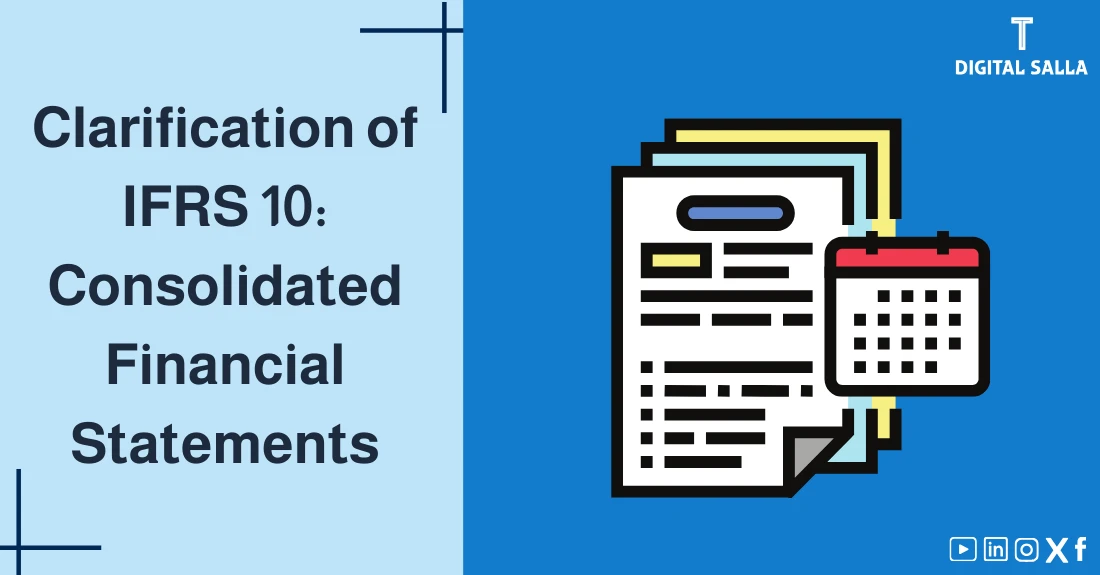Clarification of IFRS 10 Standard: Consolidated Financial Statements

IFRS 10 Standard, “Consolidated Financial Statements,” provides a comprehensive framework for the preparation and presentation of consolidated financial statements for a group of entities controlled by a parent company. IFRS 10 Standard establishes the principle of control as the basis for consolidation and provides guidance on how to apply this principle in various situations. This article offers a thorough explanation of IFRS 10 Standard, discussing its objectives, scope, and key requirements. We’ll focus on the definition of control and its elements, the requirements for preparing consolidated financial statements, exemptions from consolidation, and highlight the standard’s significance and its impact on the presentation of the group’s financial position and performance.
What are Consolidated Financial Statements?
Consolidated financial statements are the financial statements of a group of companies presented as if they were a single economic entity. The group includes the parent company (the controlling company) and all its subsidiaries (companies controlled by the parent company). Consolidated financial statements present the assets, liabilities, equity, income, expenses, and cash flows of the parent and its subsidiaries as if they were a single entity.
Example:
If Company “A” owns 100% of the shares of Company “B,” then Company “A” is the parent company, and Company “B” is a subsidiary. Company “A” prepares consolidated financial statements that include the assets, liabilities, equity, income, expenses, and cash flows of both Company “A” and Company “B” as if they were one company.
What is IFRS 10: Consolidated Financial Statements?
IFRS 10 is an international accounting standard that sets out the requirements for the preparation and presentation of consolidated financial statements. IFRS 10 replaces IAS 27, “Consolidated and Separate Financial Statements,” and the portion of SIC-12, “Consolidation – Special Purpose Entities,” that dealt with accounting for subsidiaries.
Objectives of IFRS 10 Standard:
- Establish the Principle of Control as the Basis for Consolidation: IFRS 10 Standard provides a clear definition of the principle of control and identifies its key elements.
- Set Uniform Accounting Requirements for Preparing Consolidated Financial Statements: IFRS 10 Standard specifies how to prepare and present consolidated financial statements, ensuring consistency and reliability of financial information.
- Improve the Quality of Disclosures: IFRS 10 Standard imposes specific disclosure requirements aimed at improving the transparency and understanding of the group structure and the relationships between controlling and controlled entities.
- Enhance Comparability: IFRS 10 contributes to improving the comparability of the consolidated financial statements of different groups.
Scope of IFRS 10 Standard :
IFRS 10 applies to all entities that control one or more other entities, except for certain investment entities that meet specific criteria and may fall under IFRS 9. The standard specifies how to prepare and present the consolidated financial statements of the group.
The Principle of Control: The Basis for Consolidation
The principle of control is the foundation that determines whether a parent company must consolidate the financial statements of another entity (the subsidiary) into its consolidated financial statements. An investor controls an investee when the investor is exposed, or has rights, to variable returns from its involvement with the investee and has the ability to affect those returns through its power over the investee.
Elements of Control According to IFRS 10 Standard:
All three of the following elements must be present for a parent company to be considered to control a subsidiary:
- Power: The parent company has existing rights that give it the current ability to direct the relevant activities of the subsidiary—that is, the activities that significantly affect the subsidiary’s returns. Power typically arises from voting rights, but it can also arise from other contractual rights.
- Returns: The parent company is exposed, or has rights, to variable returns from its involvement with the subsidiary. These returns can be positive, negative, or both.
- Link between Power and Returns: The parent company has the ability to use its power to affect the amount of the investor’s returns from the subsidiary.
Assessing Control:
Assessing control requires a thorough examination of the facts and circumstances surrounding each case. IFRS 10 Standard provides guidance on how to assess control in some specific situations, such as:
- Control through Voting Rights: Control usually arises when the parent company owns more than 50% of the voting rights in the subsidiary. However, control can exist even if the parent company owns less than 50% of the voting rights, if it has the ability to direct the relevant activities through contractual or other agreements.
- De facto Control: A parent company may control a subsidiary even if it does not own a majority of the voting rights, if it has the practical ability to unilaterally direct the relevant activities.
- Protective Rights: Protective rights, such as a lender’s right to prevent a company from selling its assets, do not prevent a parent company from controlling the subsidiary.
- Agency: A distinction must be made between a decision-maker acting as an agent for other parties and a decision-maker acting as a principal. An agent does not control the subsidiary even if it has decision-making authority.
- Potential Voting Rights: Potential voting rights, such as share options, must be considered when assessing control if these instruments are substantively convertible into ordinary shares.
Requirements for Preparing Consolidated Financial Statements:
- Consolidate All Subsidiaries: The parent company must consolidate the financial statements of all its subsidiaries, regardless of its ownership percentage in these companies, as long as it controls them.
- Use Uniform Accounting Policies: The parent company and its subsidiaries must use the same accounting policies when preparing the consolidated financial statements. If a subsidiary uses different policies, its financial statements must be adjusted before consolidation.
- Eliminate Intercompany Transactions and Balances: All intercompany transactions and balances between group companies, such as sales, purchases, and loans, must be eliminated when preparing the consolidated financial statements.
- Determine Non-controlling Interest (NCI): If the parent company does not own 100% of the shares of the subsidiary, the non-controlling interest must be recognized in the consolidated financial statements. The NCI represents the rights of other shareholders (other than the parent company) in the net assets and results of operations of the subsidiary.
- Prepare Consolidated Financial Statements as if the Group Were a Single Entity: The assets, liabilities, equity, income, expenses, and cash flows of the group should be presented as if it were a single economic entity.
Exemptions from Consolidation:
IFRS 10 Standard exempts some entities from preparing consolidated financial statements in certain cases, such as:
- If the parent company is itself a wholly-owned or partially-owned subsidiary of another entity, and its other owners, including those not otherwise entitled to vote, do not object to the parent not presenting consolidated financial statements.
- If the parent company’s debt or equity instruments are not traded in a public market.
- If the parent company did not file, nor is it in the process of filing, its financial statements with a securities commission or other regulatory organization for the purpose of issuing any class of instruments in a public market.
- If the ultimate or any intermediate parent of the entity produces consolidated financial statements available for public use that comply with IFRSs.
Note: An entity that is exempt from preparing consolidated financial statements must disclose this fact in its separate financial statements.
Disclosure Requirements Under IFRS 10 Standard: IFRS 10 Standard requires entities that present consolidated Financial statements to provide disclosures in relation to:
- Basis for Consolidation: The accounting policies used in preparing the consolidated financial statements must be disclosed, including how control is assessed.
- Subsidiaries: A list of all subsidiaries must be disclosed, the parent company’s ownership percentage in each subsidiary, and the nature of the activities carried out by each subsidiary.
- Non-controlling Interest: The non-controlling interest in the net assets and results of operations of the subsidiaries must be disclosed.
- Any significant restrictions on the parent company’s ability to access or use the assets of the subsidiaries and settle the liabilities of the subsidiaries.
- The nature and extent of any interests in unconsolidated structured entities Importance of IFRS 10 for Users of Financial Statements:
IFRS 10 Standard provides valuable information to users of financial statements, such as investors and analysts, as it helps them to:
- Understand the Group Structure: IFRS 10 Standard clarifies the relationships between the parent company and its subsidiaries and how these relationships affect the financial statements.
- Assess the Performance of the Group as a Whole: Consolidated financial statements provide a comprehensive picture of the performance of the group as a whole, not just the performance of the parent company separately.
- Analyze Risks and Returns: Users of financial statements can assess the risks and returns associated with investing in the group as a whole.
- Compare the Performance of Different Groups: IFRS 10 Standard helps to improve the comparability of the consolidated financial statements of different groups.
- Understand the Nature of Intercompany Transactions: The disclosures required by IFRS 10 help in understanding the nature of transactions between group companies and their impact on the consolidated financial statements.
Challenges in Applying IFRS 10 Standard:
- Assessing Control: Assessing control can be difficult in some cases, especially when there are complex contractual agreements or potential voting rights.
- Identifying Relevant Activities: It may be difficult to identify the relevant activities that significantly affect the returns of the subsidiary.
- Gathering Financial Data from Subsidiaries: It may be difficult to gather financial data from subsidiaries, especially if these companies operate in countries with different accounting practices.
- Harmonizing Accounting Policies: It may be difficult to harmonize the accounting policies used by the parent company and its subsidiaries, especially if these companies operate in different industries.
Practical Example of Applying IFRS 10 Standard:
Scenario: Company “X” owns 80% of the shares of Company “Y.” Company “X” has the right to appoint and remove the majority of the members of the board of directors of Company “Y” and has the ability to direct the financial and operating policies of Company “Y.”
Analysis:
- Control: Company “X” controls Company “Y” because it owns a majority of the voting rights and has the ability to direct the relevant activities of Company “Y.”
- Consolidation: Company “X” must prepare consolidated financial statements that include the assets, liabilities, equity, income, expenses, and cash flows of both Company “X” and Company “Y.”
- Non-controlling Interest: Company “X” must recognize the non-controlling interest (20%) in the net assets and results of operations of Company “Y” in its consolidated financial statements.
Note: For a deeper understanding of IFRSs in general, you can refer to articles/resources on International Financial Reporting Standards.
Conclusion:
IFRS 10 Standard is a fundamental tool for preparing consolidated financial statements, as it provides a clear framework for identifying and assessing control and imposes specific requirements for consolidating financial statements and disclosing information related to the group. Understanding IFRS 10 Standard is essential for accountants, auditors, investors, and anyone seeking to understand how multinational companies operate and how to assess their financial performance. The correct application of IFRS 10 contributes to enhancing the transparency and reliability of financial reports and supports the efficiency of capital markets.
